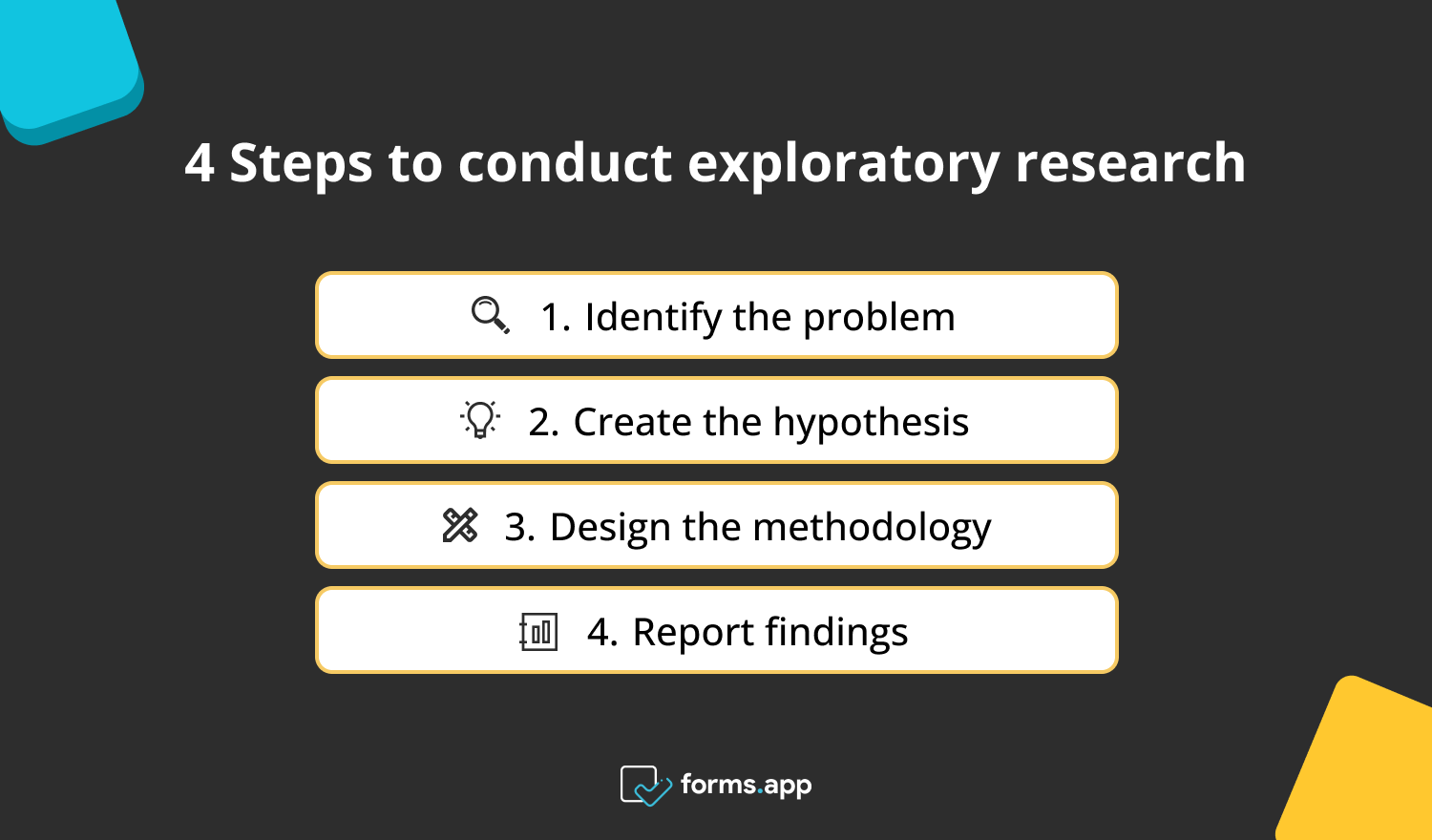Imagine that you are an owner of a bakery that is successfully selling cupcakes and birthday cakes. And you have a business idea about adding donuts to your inventory to sell to your customers. But before investing in that idea, you want to have some information to see whether or not this is a good idea for your business. But how do you obtain such data?
In this scenario, the research method you should go with is exploratory research design. It is a form of research that lets you explore new areas while looking at new sources and old databases. Let us start with the definition of explorer research.
What is exploratory research?
As the name implies, exploratory research is about “exploring.” It is a type of research design where the researcher is trying to understand a subject matter that has not been explained before.
Or, in some cases, exploratory research is used when a research topic does not effectively answer questions, and it should be researched further. (Because it is quite difficult to find a topic that was not touched on before.) For example, your research problem could be about selling items or marketing research.
In Layman’s terms, exploratory research is trying to discover new things or discover more stuff about anything.
Exploratory research examples
Exploratory research can be used in many fields, from medicine to marketing to education. Exploratory research is used when the administrators want to come up with new marketing strategies and when a new medical discovery will be made. Much like the exploration itself, the possibilities are endless. Let us see some exploratory research question examples:
- Does distributing contraceptives to high schoolers have a positive impact on eliminating teen pregnancies?
- Are unmarried women less likely to get heart diseases?
- What type of video marketing method works the best on middle-class workers?
- What are the key motivations and barriers to using digital devices for the education of children?
- What are the main reasons behind the decline in customer satisfaction with a specific service?
- What are the main challenges faced by women-owned small businesses?
- What factors contribute to employee turnover, and what strategies can be implemented?
- What are the different segments within the target market and what unique preferences and behaviors make up the characteristics of each segment?
- What factors contribute to the customer perception at the moment?
Data collection in exploratory research
Data collection is a critical part of exploratory research, even though it can be challenging to obtain data on a never-explored subject. Data collection helps narrow down the subject and figure out what kind of research has been done before. Data collection for exploratory research can be done in two different ways. The researcher can use primary research and secondary continue.

Data collection methods in exploratory research
Primary research methods
Primary search is a type of research method where, during this method, you obtain knowledge directly from the source. It means talking to research participants, surveying a target audience, and doing observations without interference. Let us learn more about them:
1. Focus groups
Using focus groups can give you unbiased and fast data about the subject you want to explore. You can have two groups of people and see how different groups react to different elements. With this research approach, you can get a good idea of which of the two ways is better for your company.
2. Surveys
Surveys are a great way to reach your audience and directly communicate with them. You can ask your questions and get immediate answers. When you use an online survey maker and create your surveys with your unique questions, you can collect answers without a sweat!
3. Interviews
Interviews can be done both spontaneously and preplanned. When constructed with open-ended questions, it gives valuable insight to researchers. For example, the bakery owner mentioned above can briefly ask their loyal customers what more they would like to see in their shop. That is a great way to use exploratory research for marketing purposes.
4. Observations
Observation is a type of method where you gather the appropriate information from sheer observation when there is no interference. The searcher can set up cameras and observe the people in their own environments, or they can set up an environment where they can see the people’s reactions to something.
Secondary research methods
Secondary research is a type of research method you do not go to the source. You obtain the appropriate data about the subject from already published documents and studies completed.
The secondary research method is mostly done when doing primary research will be unethical or impractical. There are different source materials a researcher can make themselves. They can be physical copies of documents or books or online citations. You can also learn about secondary research on the blog of forms.app.
1. Collecting data from the internet
There are many useful academic papers and documents that can be found online. When the subject to be researched is clear, the researchers can look through online papers. Other online sources include the websites of competitors and social media platforms.
2. Reviewing publications
This method is quite similar to collecting data from the Internet, except these publications are physical copies. The published sources can be textbooks, journals, magazines, case studies, newspapers, and business journals. If you are operating a business and want to improve your sales in a way, you can go through annual reports of similar businesses to get a good idea.
Advantages & disadvantages of exploratory research
When trying to discover new aspects on a certain subject, exploratory research gives a good starting point. The researcher does not know where they will end up, that is why they are not limited to the framework of their research methods.
However, this does not mean exploratory research is the only way. The researcher should always be mindful when it comes to the positive and negative sides of this research type. Here are the advantages and disadvantages of exploratory research:
Advantages of exploratory research
- Exploratory research enables researchers to be flexible, as the direction of the study can change according to what is found. As they try to “explore” and not reach a goal, there are not many limitations.
- Exploratory research is usually low in cost as the study can proceed however you think is the best.
- Exploratory research enables researchers to find out whether or not the topic is worth exploring further. It is an effective way to see where the subject will go.
- The researcher is saved from spending more time and resources if the topic is deemed impractical to study.
Disadvantages of exploratory research
- As the research is done on a small number of subjects, the study is usually not externally valid and can not be generalized to all.
- Exploratory research gives a good idea on the topic, but it is mostly inconclusive.
- The results of exploratory research consist of qualitative data, and the interpretation of such data can be biased.
- When a secondary research method is used, the sources used can be outdated or old.
How to conduct exploratory research (step-by-step guide)

Essential steps to conduct exploratory research
Until this part, we learned when to use exploratory research design, how to collect data, and the advantages and disadvantages of exploratory research. And now, if you believe this is the method for you, we can go through how to create one. Let us see the step-by-step guide:
Step 1: Identify the problem
First, identify the question you want answered. It does not have to be a specific question but a broad one. Because exploratory research is about exploring and finding out new things, it is perfectly okay to change direction according to your findings.
Step 2: Create the hypothesis
When you clearly identify the problem, you can create an initial hypothesis. Basically, you make an estimation of the outcome of the study. This allows you to go to the next step smoothly. And do not forget that you can change the theory according to what you find.
Step 3: Design the methodology
Determine the most suitable methodology for your problem. When it involves people and requires immediate answers, you can try surveys and interviews. But if it is a question about statistics and long-time manners, you can go through existing secondary sources.
Step 4: Report findings
After using the data you collected to identify patterns, themes, and trends, you can confidently report your findings. The findings will allow you to act accordingly, and you can make the best decision for your business.
Conclusion
When there is a study question needs to be answered, one of the effective research methods is exploratory research. During this method, the researcher tries to answer a question that has never been asked before. Or, they can build on a previously studied subject if they think the findings are not enough or are outdated.
This researcher can go with either a primary research method, a secondary research method, or even a mix of the two. If you are starting your own research, forms.app is a powerful tool that has many useful features. Be sure to check it out!
forms.app, your free form builder
- Unlimited views
- Unlimited questions
- Unlimited notifications



